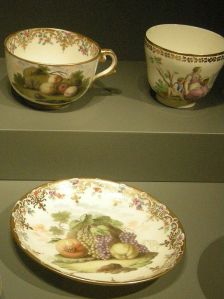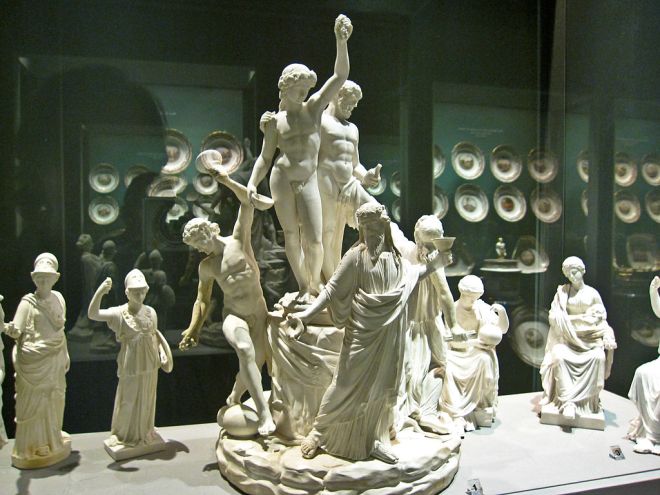In the early 1700s, porcelain produced at Meissen became all the rage in Europe. The King of Naples and Sicily, Charles VII, married Maria Amalia, whose grandfather Augustus II of Poland had founded the Meissen factory, the first hard-paste porcelain factory in Europe.

18th c. Capodimonte porcelain examples from the National Gallery of Victoria (Australia). Photo: by Sailko, from Wikimedia Commons.
Pursuing his interest in the art, Charles VII founded the Capodimonte (top of the mountain) Porcelain factory in Naples in 1743. Production was well under way when Charles’ father, the King of Spain, died in 1759 and Charles took the Spanish throne and left the throne of Naples to his son Ferdinand. Before he left, however, he ordered the porcelain works demolished, and took the molds with him to Spain to found another factory there.
Ferdinand IV wasn’t so easily dissuaded–he had come to appreciate the porcelain art himself, and re-established the Capodimonte factory in 1772. The detailed history (some found here) is more complex and involved a lot of experimentation with the porcelain “recipe”, hiring of various artists, chemists, directors, and so forth, and the establishment in Naples of an art academy.

Elaborate bisque figures, “The Triumph of Bacchus” from the Capodimonte Museum in Naples. Image from Wikimedia Commons.
Ferdinand was soon embroiled in Napoleon’s schemes for Italy, (I’ve posted about that before) and production of the royal sponsored Capodimonte porcelain ceased around 1818. The factory was purchased by Claudio Guillard and Giovanni Tourne, who continued to used the same mark as the royal factory. In 1834 the company was purchased by a Florentine, and about 1896 they combined interests with the Societa Ceramica Richard of Milan. They continue to produce porcelain in the Capodimonte style, and the style is widely copied today.

The Judgement of Paris, now in the Capitoline Museum in Rome. Colorful and elaborate figures typically linked with Capodimonte style. Image from Wikimedia Commons.
Most of the 18th century products are in museums or collections of the wealthy today. Are you interested in buying some later pieces? Here are some listing from Ebay.com. Some claim to be 19th century pieces, and others are newer.
QUESTION: What is your favorite art or craft from southern Italy? Please comment!

Pingback: Italy’s Capodimonte porcelain – love it or not | Auction Finds